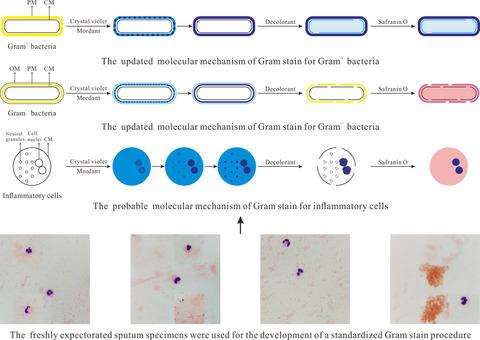当前位置:
X-MOL 学术
›
Microbiologyopen
›
论文详情
Our official English website, www.x-mol.net, welcomes your
feedback! (Note: you will need to create a separate account there.)
Development of a standardized Gram stain procedure for bacteria and inflammatory cells using an automated staining instrument.
MicrobiologyOpen ( IF 3.9 ) Pub Date : 2020-06-27 , DOI: 10.1002/mbo3.1099 Hui Li 1 , Lele Li 1 , Yuanyuan Chi 2 , Qingwu Tian 1 , Tingting Zhou 1 , Chunhua Han 1 , Yuanqi Zhu 1 , Yusun Zhou 1
MicrobiologyOpen ( IF 3.9 ) Pub Date : 2020-06-27 , DOI: 10.1002/mbo3.1099 Hui Li 1 , Lele Li 1 , Yuanyuan Chi 2 , Qingwu Tian 1 , Tingting Zhou 1 , Chunhua Han 1 , Yuanqi Zhu 1 , Yusun Zhou 1
Affiliation

|
Gram stain is a subjective and poorly controlled test, and the resultant errors often perplex laboratory scientists. To reduce errors and make Gram stain a precisely controllable and meritorious test, a standardized Gram stain procedure for bacteria and inflammatory cells was developed using an automated staining instrument in this study. Freshly expectorated sputum specimens, used as the optimized targets, were smeared on slides by laboratory technicians, defining each slide loaded with uniform matrix and monolayer cell. And then, the staining and decolorizing time, as well as the stain and decolorant volume, were optimized as 15, 105, 1, and 25 s and 1.1, 1.4, 0.3, and 0.7 ml, respectively. Culture‐positive blood specimens and original purulent fluids were used for confirming the developed standardized Gram stain procedure. Distinct tinctures of bacteria and inflammatory cells adhered to slide uniformly in a monolayer were observed, and the obtained staining results of these samples were highly consistent with their cultured results. Furthermore, according to the staining results under different staining conditions, an updated molecular mechanism of Gram stain for bacteria and the probable staining mechanism for inflammatory cells were also proposed in this study.
中文翻译:

使用自动染色仪开发用于细菌和炎性细胞的标准化革兰氏染色程序。
革兰氏染色是一种主观的且控制较差的测试,所产生的错误通常使实验室科学家感到困惑。为了减少错误并使革兰氏染色成为可精确控制和立功的测试,本研究中使用自动染色仪开发了用于细菌和炎性细胞的标准化革兰氏染色程序。由实验室技术人员将用作最佳靶标的新鲜痰标本涂在载玻片上,确定每个载玻片上均装有均匀基质和单层细胞。然后,将染色和脱色时间以及污渍和脱色剂体积分别优化为15、105、1和25 s,以及1.1、1.4、0.3和0.7 ml。培养阳性的血液标本和原始化脓液用于确认已开发的标准化革兰氏染色法。观察到细菌和炎性细胞的独特tin剂粘附在单层上均匀地滑动,并且这些样品的染色结果与它们的培养结果高度一致。此外,根据不同染色条件下的染色结果,还提出了革兰氏染色细菌的分子机制和炎性细胞可能的染色机制。
更新日期:2020-06-27
中文翻译:

使用自动染色仪开发用于细菌和炎性细胞的标准化革兰氏染色程序。
革兰氏染色是一种主观的且控制较差的测试,所产生的错误通常使实验室科学家感到困惑。为了减少错误并使革兰氏染色成为可精确控制和立功的测试,本研究中使用自动染色仪开发了用于细菌和炎性细胞的标准化革兰氏染色程序。由实验室技术人员将用作最佳靶标的新鲜痰标本涂在载玻片上,确定每个载玻片上均装有均匀基质和单层细胞。然后,将染色和脱色时间以及污渍和脱色剂体积分别优化为15、105、1和25 s,以及1.1、1.4、0.3和0.7 ml。培养阳性的血液标本和原始化脓液用于确认已开发的标准化革兰氏染色法。观察到细菌和炎性细胞的独特tin剂粘附在单层上均匀地滑动,并且这些样品的染色结果与它们的培养结果高度一致。此外,根据不同染色条件下的染色结果,还提出了革兰氏染色细菌的分子机制和炎性细胞可能的染色机制。





















































 京公网安备 11010802027423号
京公网安备 11010802027423号